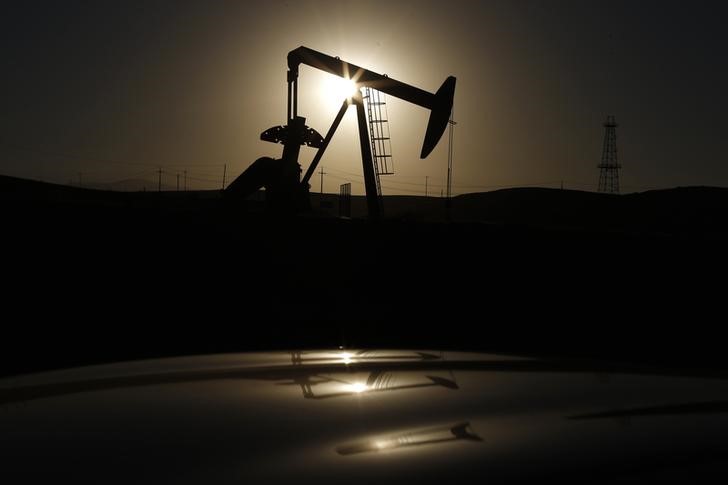By Mike Dolan
LONDON (Reuters) - The biggest financial risk in 2016 may be the one that's been on stage all year.
In Britain's popular Christmas pantomime shows, audiences scream out "He's behind you!" as a warning to the hero whenever the villain appears.
That refrain is almost audible as investment strategists scan 2016 for risk events, as the well-known baddie of plummeting oil prices re-emerges from behind the curtain.
It's so familiar now, it's hard to register a further oil price drop as a 'new' risk, however.
Financial markets have been living with the consequences of the energy deflation since mid-2014, and the fallout has been pervasive. The idea of another shock of that magnitude is unnerving to say the least.
More than a trillion dollars of market capitalization has been wiped off oil stocks worldwide.
Almost $2 trillion of debt sold by energy and mining companies since 2010, many of them high-yield or 'junk' bonds from small shale gas firms, are facing a wave of credit rating downgrades and defaults are rising.
About 2 trillion euros of European government debt is now yielding less than zero percent after oil-seeded deflation scares forced the inflation-targeting European Central Bank to begin a bond-buying spree earlier this year.
The impact on inflation forecasts of yet another sustained drop in oil prices has been alarming as much for central banks about to tighten, such as the Federal Reserve, as for those still easing, like the ECB.
What's more, the scale of the hit to commodity exporting nations from Russia to Brazil and SouthEast Asia has stood out. Their currencies have imploded, and 2015 is set to mark the first year of a net private capital outflow from emerging markets since 1988.
Given the scale of the oil price drop, it's not hard to see why markets have rewritten so many scripts.
Since June 2014, Brent crude has plunged 65 percent from $115 per barrel to $40. Much of that implosion happened in the last six months of last year, but any hopes of a rebound this year evaporated amid a toxic mix of a swelling supply glut and steep demand slowdowns in China and emerging economies.
The prospect of living with oil prices that just stay around here and don't bounce back to at least $60 was already going to be a major challenge for many exposed companies and economies - not least as they brace for next week's U.S. interest rate rise.
But for all the myriad market risks outlined by banks for the year ahead - ranging from Middle East conflict and geopolitics, central bank policy 'mistakes', market liquidity shocks or even Britain voting to exit the European Union - very few list yet another halving of oil prices.
And yet, after last week's OPEC meeting broke up in disarray with no agreement on supply cuts or even a reference to production caps, crude prices have given up the ghost again.
Brent has plumbed new lows below $40 per barrel this week, while U.S. crude slumped under $37. Even the rolling annual average price, at less than $55, has halved in just 18 months and continues to slide.
'NEW OIL ORDER'
Long-term oil price bears Goldman Sachs (N:GS) reckon that any thought of a rebound or even stabilization in 2016 are way off the mark and that US crude could shed almost 50 percent from here to $20.
"There is a risk that a milder winter, slower EM growth, and the (potential) lifting of international Iranian sanctions will cause inventories to build further," the bank told clients this week. "These factors imply that the near-term risks to the forecast remain skewed to the downside. If oil prices breach logistical and storage capacity, they think oil prices could collapse to production costs as low as $20/bbl."
If that proved correct, it would pull out another thread in this year's already unravelling market.
And the market stress gets amplified in many different ways - not least in the drain on world markets from lower central bank reserves and petrodollar savings in big energy exporting nations. The rundown of these savings combined with rising Federal Reserve interest rates could well put upward pressure on long-term interest rates over time as the reversal of the commodities supercycle twins with its bond market equivalent.
New investments in global equities, bonds and real estate from oil-fueled sovereign wealth funds are already drying up amid reports of billions of dollars of withdrawals by state institutions from private asset managers.
The foreign assets of the Saudi Arabian Monetary Agency alone are shrinking at an annual rate of more than $120 billion.
"If the global economic expansion continues, as we expect, then rising investment demand will eventually expose the market consequences of ebbing petrodollar saving flows," Goldman Sachs told clients.
The combination of lower-for-longer oil and higher real rates could be toxic for corporate credit and emerging markets.
Forecasting a rise in oil and mining sector bond defaults next year and "staggering adverse conditions" for those firms, Moody's credit rating firm said the only things delaying this in 2015 were temporary cushions in hedging programs, fixed-price contracts and the rundown of existing cash balances.
But that could all change next year if oil prices don't recover or even continue to fall.
"Diminishing liquidity and restricted access to capital markets are now pushing more firms closer to default," Moody's Managing Director Daniel Gates said last week.
And for those itching to return to battered emerging market equity and debt, the message is clear:

"Investors should continue to keep their guard up in 2016," Morgan Stanley (N:MS) told clients this week.
(Graphics by Alistair Smout and Vincent Flasseur; Editing by Hugh Lawson)